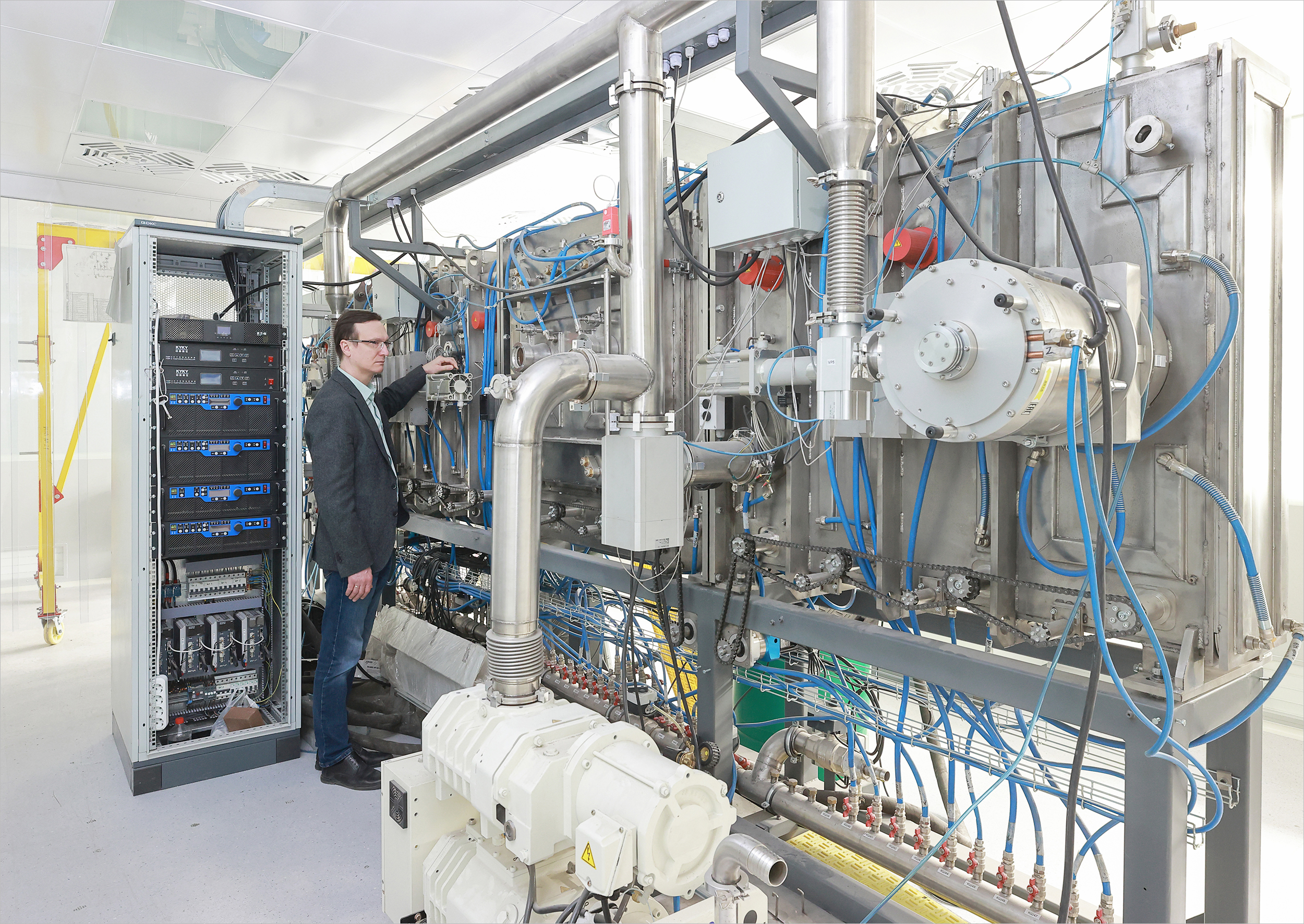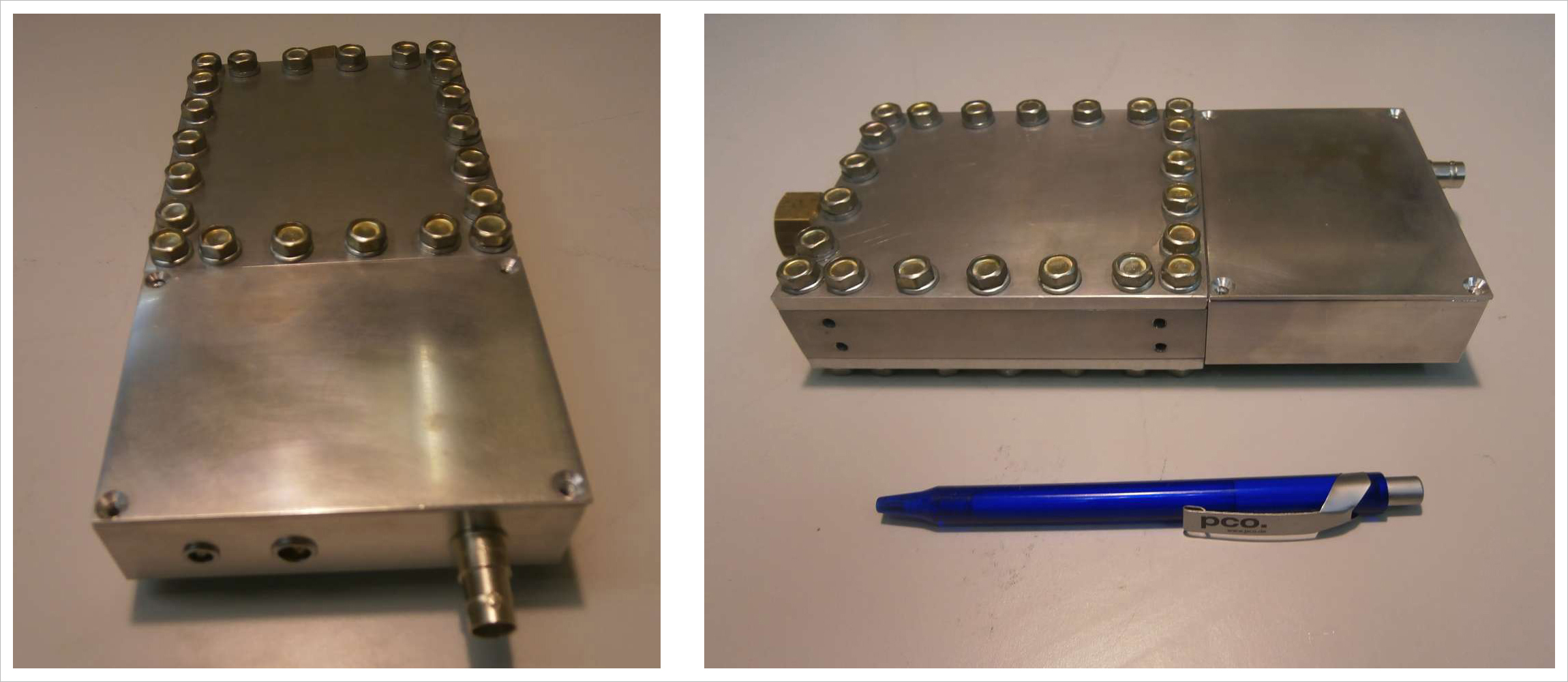Creation of experimental production site of neutron detectors at JINR
News, 21 April 2023
At the Laboratory of Neutron Physics JINR, specialists are completing the creation of the experimental site for the development and production of thermal neutron detectors based on a boron carbide converter. They will put the site into operation at the end of this year. It will provide neutron scattering facilities with modern detectors at the IBR-2 Reactor, as well as other research centres in Russia and abroad.
According to Head of the FLNP Department of IBR-2 Spectrometers Complex Viktor Bodnarchuk, the experimental site is a small high-tech production area located in building No. 119 of FLNP JINR. The core of the site is an industrial vacuum magnetron sputtering facility of the through type VATT-800 (“Ferry Vatt” LLC, Kazan) aimed at applying 10B4C boron carbide thin-film coating over flat substrates with an area of up to 1,200 x 400 mm. The experimental site includes rooms for fine processing of metal parts, a room to prepare substrates for sputtering, a detector assembly site with an area for soldering and adjusting electronics, and a room with a radioactive source for testing prepared detectors.
 The VATT-800 facility (“Ferry Vatt”, Kazan) to apply 10B4C boron carbide thin-film coating over flat substrates by magnetron sputtering
The VATT-800 facility (“Ferry Vatt”, Kazan) to apply 10B4C boron carbide thin-film coating over flat substrates by magnetron sputtering
The first users of new neutron detectors will be research groups of JINR and the National Research Centre “Kurchatov Institute”. Specialists have already received requests for detectors for experimental stations at the IBR-2 Reactor, as well as the PIK Reactor (Gatchina) and IR-8 (Moscow). Experts create each detector according to an individual task for a certain experimental facility. They will develop the following types of detectors: counters, beam monitors, and position-sensitive detectors. Each type has its own characteristics, such as positional sensitivity, spatial and time resolution, input window area, etc.
“We are creating an experimental site for the development of thermal and cold neutron detectors, in which the boron-10 carbide isotope acts as a converter,” Viktor Bodnarchuk said. He explained that most detectors at the spectrometers of the IBR-2 Reactor are currently based on the helium-3 isotope. This gas is a product of artificial origin, its quantity is limited and insufficient to meet demand, which has led to its high cost. Therefore, at present, many research centres in the world are looking for alternative technologies to register neutron radiation.
A neutron is a neutral particle that has no charge. It is possible to register it only when it is captured by the nucleus of an atom of a converter. During the capture, it decays with such decay products as charged particles and/or gamma quanta. Specialists register a neutron thanks to the detection of ionisation by the gas decay products or the detection of luminescence in a scintillator, a substance that emits light when the decay products are absorbed. As a result, an electrical signal is generated, which is provided by the detector. In this process, the neutron is absorbed by the nucleus and ceases to exist.
There is a limited number of isotopes in nature that can be used as neutron converters. They are helium-3, boron-10, gadolinium, cadmium, and lithium. “The last three are very sensitive to gamma radiation, so there is an additional background during the operation of a detector. Using boron-10, it is easier to separate neutron signals from background gamma radiation and isolate a pure signal from a neutron,” the scientist said. Moreover, a 10В isotope, used in the nuclear industry in the form of solid-state boron carbide 10В4С, is industrially available and less expensive. The thermal neutron capture cross section of 10В is 0.7 of the cross section of 3Не (3,840 barn/5,400 barn). It allows specialists to consider it as a suitable converter for the development of neutron detectors. More significantly, 10В-based detectors have higher spatial and time resolution. Spatial resolution reflects the accuracy of detecting the particle position in the detector. Time resolution is the minimum time interval between two particles registered as separate events.
Employees of the Department of IBR-2 Spectrometers Complex in cooperation with their colleagues of the University “Dubna” began the development of a technology for applying 10В enriched boron carbide over large-area bases in 2017. The technology allows experts to obtain amorphous 10В4С coatings with thickness from units of nanometers to several microns with high adhesion to the base. Such films have density close to natural, high flexibility, and hardness at the same time. Specialists make coatings at temperatures from 50 to 200 °C. It allows them to apply coatings to thin foil and polymer films. Experts firstly used the 10В4С-based converter in a test model of the neutron beam monitor for the YUMO Small-Angle Neutron Scattering Spectrometer, located at the 4th channel of the IBR-2 Reactor. Its tests have shown reliable and good performance.
 Beam monitors with converter based on boron carbide 10В4С applied to aluminium plate
Beam monitors with converter based on boron carbide 10В4С applied to aluminium plate
“Based on the first successful technology, we are already developing small detectors. At present, specialists are adjusting the production technology of detectors and developing related electronics. We are just at the very start of the process,” Viktor Bodnarchuk said. He explained that developed technologies would allow experts to produce detectors with an area of up to 400 x 1,200 mm after the launch of the experimental site. They will be able to combine individual elements of such detectors with each other, extending the surface of the detector.
Nevertheless, boron-coated detectors have drawbacks that scientists are working on. The first one is low efficiency of neutron registration, which is significantly less than that of neutron registration based on helium-3. Boron carbide is a dense solid material, whilst helium is a gas. It is easier to register neutrons in gas, as specialists register decay products emitted by the nucleus as a result of its neutron capture in 100% of events. However, decay products can get stuck in solid material. Thus, they will not get working gas to be registered. “We need to increase this parameter so that it meets the needs of experimental physicists who work at neutron scattering facilities,” the scientist highlighted.
Not all particles of the decay of the boron-10 isotope, which are a helium particle and the lithium-7 isotope (4Не and 7Li), can be registered because they can remain either in the substrate or in the 10В4С boron carbide layer. If the 10В4С layer is thick, then the particle may not go beyond the layer, and the neutron will not be registered. On the contrary, if the layer is too thin, then the possibility of neutron capture will be very small, as the neutron will pass through it, and experts will register few neutrons. The optimal layer thickness is about 2.5 microns. The efficiency of such a layer for thermal neutrons is 5-8%, while the efficiency of 3Не detectors can reach up to 90%.
The technical solution to increase efficiency is the use of a multilayer detector design. In this case, if the number of layers is more than 30, it is possible to achieve the efficiency of up to 60%. At the same time, the optimal thickness of each layer is about 1 µm. Another technical solution is to install the converter layer at a sliding angle to the incident neutrons no more than 5°. In this case, the neutron moves in the near surface layer and travels the distance more than 10 times longer than the thickness of the layer. The possibility of capture increases and registration of decay particles is possible at the same time.
“If the surface is positioned at an acute angle to the incident radiation, the neutron detection efficiency increases significantly. Physicists are interested in the efficiency of 60%,” Viktor Bodnarchuk explained. For different methods of neutron research, specialists use different ways to increase the efficiency of detectors. Thus, for reflectometry, they prefer placing planes at an acute angle. However, for diffraction, they prefer using multilayer detectors. Calculations and practical experience by foreign scientific centres show that the sensitivity of detectors can be about 90% of the efficiency of 3Не detectors.
At the moment, as part of the creation of the laboratory, specialists have developed technical documentation for the first samples of detectors, adjusted the technology of applying boron carbide, tested the first assembly versions. “Over the past year, we have been producing pilot models of detectors, which we will further test at the IBR-2 Reactor as a finished product,” Viktor Bodnarchuk summed up.
Experts will put into operation the experimental site for the development of neutron detectors at the end of 2023. They started the implementation of the project in 2021 within the framework of a three-year grant from the Ministry of Science and Higher Education of Russia. Thanks to the grant, it was possible to join efforts of detector groups of DLNP JINR, VBLHEP JINR, and PIK together with the JINR Department of IBR-2 Spectrometers Complex to develop advanced neutron detectors based on 10В4С. It gives hope for the forthcoming production of world-class advanced neutron detectors in Russia. The National Research Centre “Kurchatov Institute”, the PNPI, the Institute for Nuclear Research of RAS, the Institute of Metal Physics of the Ural Branch of RAS, as well as MIPT, Kazan Federal University, and the State University “Dubna” are engaged in the project.
Thus, JINR is becoming a centre for the development and production of world-class advanced thermal neutron detectors based on 10В4С isotope capable of re-equipping its facilities by modern detectors and providing research centres in Russia, the CIS countries, and other countries with them.